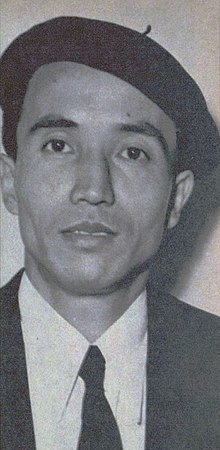Noboru Nakamura
Noboru Nakamura | |
|---|---|
 | |
| Born | 4 August 1913 Negishi, Shitaya-ku, Tokyo |
| Died | 20 May 1981 (aged 67) |
| Occupation(s) | Film director, screenwriter |
Noboru Nakamura (中村登, Nakamura Noboru, 4 August 1913 – 20 May 1981) was a Japanese film director and screenwriter.[1][2]
Biography
[edit]After graduating from the Tokyo Imperial University Faculty of Letters in 1936, Nakamura joined the Shochiku film studios, working as an assistant director for Torajirō Saitō and Yasujirō Shimazu.[1][2] He debuted as director in 1941 with Life and Rhythm, and finally received recognition with his 1951 film Home Sweet Home.[1] His most noted works include the Yasunari Kawabata adaptation Twin Sisters of Kyoto (1963), The Kii River (1966) and Portrait of Chieko (1967).[1][2] Both Twin Sisters of Kyoto and Portrait of Chieko were nominated for the Academy Award for Best Foreign Language Film[3][4] Nakamura was posthumously awarded the Order of the Rising Sun, 4th class.[5]
Filmography (selected)
[edit]- Life and Rhythm (1941)
- The Ideals of Marriage (1941)
- Otoko no iki (1942)
- Omitsu no endan (1946)
- Home Sweet Home (1951)
- Nami (1951)
- Natsuko no Bōken (1953)
- Shuzenji Monagatari (1955)
- Doshaburi (1957)
- The Country Boss (1958)
- Waiting for Spring (1959)
- Marry a Millionaire (1959)
- I-Ro-Ha-Ni-Ho-He-To (1960)
- Twin Sisters of Kyoto (1963)
- The Shape of Night (1964)
- Niju issai no chichi (1964)
- The Kii River (1966)
- Lost Spring (1967)
- Portrait of Chieko (1967)
- Waga Toso (1968)
- Through Days and Months (1969)
- Waga Ko, Waga Uta (1969)
- The Song from My Heart (1970)
- Kaze no Bojô (1970)
- Shiroi Shojo (1976)
- Shiokari Pass (1977)
- Nichiren (1979)
Legacy
[edit]To celebrate Nakamura's 100th birthday, three of his films, Home Sweet Home (1951), Doshaburi (1957) and The Shape of Night (1964), were screened at the Tokyo Filmex in 2013.[6][5] The Shape of Night was also shown at the Venice Film Festival the same year.[5] Home Sweet Home and Doshaburi were screened in the Forum section of the 2014 Berlin International Film Festival.[7][8]
References
[edit]- ^ a b c d "中村登 (Nakamura Noboru)". Kinenote (in Japanese). Retrieved 28 June 2022.
- ^ a b c "中村登 (Nakamura Noboru)". Kotobank (in Japanese). Retrieved 28 June 2022.
- ^ "The 36th Academy Awards (1964): Nominees and Winners". Oscars.org. Retrieved 28 June 2022.
- ^ "The 40th Academy Awards (1968): Nominees and Winners". Oscars.org. Retrieved 28 June 2022.
- ^ a b c "Special Program (1). Filmmaker in Focus: Nakamura Noboru centennial anniversary". Tokyo Filmex (in Japanese). 2013. Retrieved 23 August 2023.
- ^ "Noboru Nakamura born 100 years ago" (PDF). Tokyo Filmex (in Japanese). 2013. Retrieved 28 June 2022.
- ^ "Wa ga ya ha tanoshi – Home Sweet Home" (PDF). Berlinale. 2014. Retrieved 23 August 2023.
- ^ "Doshaburi – When It Rains, It Pours" (PDF). Berlinale. 2014. Retrieved 23 August 2023.
External links
[edit]- Noboru Nakamura at IMDb
- Noboru Nakamura at the Japanese Movie Database (in Japanese)
